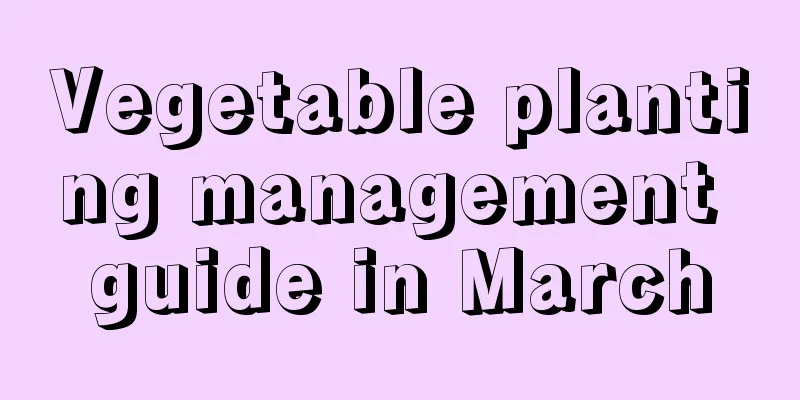Vegetable planting management guide in March

|
March is a critical period for spring vegetable planting. The rainfall gradually increases, and the duration and intensity of sunlight gradually increase, which is conducive to the photosynthesis of vegetables. However, the temperature fluctuates greatly in early spring, so insulation measures need to be taken. Below, the editor will introduce the vegetable planting and management guide for March. Let’s take a look. 1. Sowing and seedling raising Melon vegetables, such as winter melon, pumpkin, bitter melon, gourd, loofah, etc., are sown in cold beds in large, medium or small plastic greenhouses in early to mid-March. Leafy vegetables are sown directly, including radish, chrysanthemum, lettuce, Chinese cabbage , amaranth, etc. 2. Temperature management The temperature in the greenhouse needs to be maintained within an appropriate range. For example, during the flowering and fruiting period of tomatoes, the temperature in the greenhouse should be less than 30°C during the day and greater than 15°C at night. The optimal daytime temperature is 26-28°C, and ventilation needs to be strengthened at this time. The climate in early spring is unstable, so anti-freeze measures must be taken, such as releasing smoke spray at night. 3. Water management Before sowing, the soil needs to be watered sufficiently and covered with plastic film to keep warm and retain moisture. Generally, no watering is required during the germination period. After the seedlings emerge, water them once to keep the soil moist. As the temperature rises and the plant grows faster, the amount and frequency of watering can be appropriately increased. The best time to water is in the morning on a sunny day. After watering, close the greenhouse film to increase the temperature, and then ventilate and dehumidify after the ground temperature rises. 4. Fertilization management Macro-element fertilizers are mainly nitrogen fertilizers, and micro-fertilizers are mainly calcium, magnesium, etc. Choose nitrate nitrogen fertilizer when the soil is more acidic, and apply ammonium nitrogen fertilizer when the soil is alkaline. As vegetables enter the middle and late stages of growth and development, their fertilizer requirements increase. The frequency and amount of watering should be appropriately increased, and fertilizer should be applied once a week in combination with watering. When applying top dressing, you need to follow the principle of small amounts and multiple times to prevent root burn. 5. Pest and disease control Prevention is the priority, and comprehensive prevention and treatment are the key. If diseased plants are found in the center, they must be removed promptly and handled outside the greenhouse. For diseases such as gray mold, downy mildew, anthracnose, etc., corresponding agents can be used for spraying prevention and control. Pay attention to the prevention and control of greenhouse whiteflies, aphids and other pests. 6. Field management In early spring, we need to guard against late spring frost. We can reduce the degree of frost damage by covering the ground with mulch when digging trenches and planting, irrigating appropriately, spraying water with a sprayer, building a coal stove for heating, and fumigating the fields. Pay attention to tilling and loosening the soil to absorb and store solar heat energy to further alleviate frost damage. For greenhouse vegetables, the greenhouse film needs to be pressed tightly to prevent strong winds from affecting the growth of vegetables. For open-field vegetables, measures such as building windbreaks can be taken to reduce wind damage. The above is an introduction to the vegetable planting and management guide for March. In the early spring of March, leafy vegetables grow rapidly. Farmers should adjust the harvesting standards according to market changes, comprehensively consider yield and price, and harvest at the right time.
|
<<: Desert Rose Cultivation Tips and Precautions
>>: Carnation cultivation tips and precautions
Recommend
What flowers can be watered with orange juice? Can it be used to water green radish?
1. What flowers can be watered with orange juice?...
How to judge whether orchids have adapted to the pot after planting, and how to water orchids that have not adapted to the pot
1. How to judge 1. Observe the leaves: Observing ...
Cultivation method of cilantro
Soil environment Garden soil is mixed with river ...
Sweet potato hydroponic culture tutorial is here, eating it is better than eating ginseng
Step 1: Pick sweet potatoes at the market Excludi...
How to cultivate Hachiyodai succulents
Hachiyo Succulent Growth Conditions Hachiya succu...
How to grow magnolia
1. Maintenance methods 1. Temperature: It has str...
What are the effects and functions of wild grapes and what are the taboos
1. The efficacy and function of wild grape Wild g...
What is the role of viburnum
The ornamental effect of Viburnum The lifespan of...
What does Mimosa look like and what do its leaves look like?
1. What does it look like? 1. Leaves: The leaves ...
How to grow wild papaya
1. Soil: Wild papaya has strong adaptability and ...
The reason why the trunk of the fortune tree becomes soft, can it be saved?
1. No nutrients are replenished for a long time W...
How to graft azalea
1. Time The method we use is actually better, but...
How to grow Milan flowers
1. Maintenance conditions 1. Watering: The amount...
What are the cultivation methods and precautions of Tiger Orchid?
Tiger orchid cultivation method When cultivating ...
How to get a high survival rate of camellia cuttings
Camellia is a widely cultivated and planted flowe...









